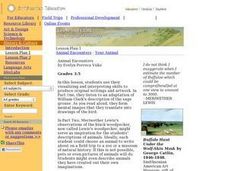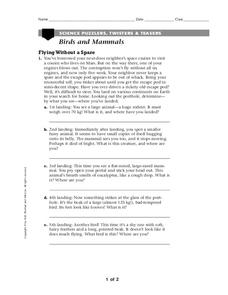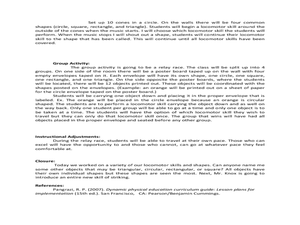Curated OER
Animal Encounters
Learners use their visualizing and interpreting skills to produce original writings and artwork.
Curated OER
Reading Research!
Students observe the pictures in non-fiction books that focus on animals in the winter. In addition, they also listed to some read aloud books about hibernation, migration, adaptation and dormancy. Students draw pictures and write notes...
Curated OER
Wildlife Habitat
High schoolers explain what a habitat is and describe its four elements. They see how an area's habitat suitability varies with different species of wildlife. They name factors that affect habitat suitability.
Curated OER
Explorit's Picnic Time Quiz
In this outdoor picnic worksheet, students complete a six question multiple choice on-line interactive quiz about animal and insect encounters that are possible while on a picnic.
Curated OER
Researching Skills: Researching on the Web
How do researchers narrow their searches so that they get the most useful and accurate information available? This essential question is at the heart of the activities suggested by a research skills worksheet. Tips include how to craft...
Curated OER
Birds and Mammals
In this science instructional activity, students create details given an imaginary story to reinforce the topics of mammals and birds. The second page has more puzzles for them to do.
Curated OER
Fish, Amphibians, Frogs
In this science worksheet, students use basic scientific concepts to complete the series of puzzles that are intended to increase science literacy for telling the differences between fish and amphibians.
Curated OER
Protists and Fungi
For this science worksheet, learners use basic scientific concepts to complete the series of puzzles about protists and fungi that are intended to increase science literacy.
Curated OER
Butterflies
In this science and reading comprehension worksheet, students read a 1 page detailed passage about butterflies. Students then answer 7 questions.
Curated OER
Natural Selection
Kids act as scientists and preditors in this short natural selection activity; they collect and analyze data, then apply their new knowledge to real-world examples of natural selection. The layout of the worksheet is easy enough to use...
Curated OER
Physical Education - Gallop
Students practice galloping. In this gross motor skills activity, students review how to jump and hop using a jump-rope and hopscotch. The teacher shows the steps to gallop and they hold a noodle and pretend as if they are riding a...
Curated OER
Missouri
In this Missouri learning exercise, students read a detailed 2 page history of the state. Students answer ten true and false questions about the passage.
Curated OER
Shapes and Review of Locomotor Skills
Students engage in a series of loco-motor activities based on shapes. In this loco-motor lesson plan, students demonstrate physical skills through races, jumping, hopping, galloping in circles, squares, rectangles and triangles.
Curated OER
The Oregon Trail
Fourth graders discover the significance of the Oregon Trail in Idaho history. In addition, 4th graders conceptualize the Oregon Trail in relation to their own lives. They engage in a wide variety of curricular activities, culminating in...
Curated OER
Verterbrate Classification
Students are introduced to the broad categories of vertebrates including fish, amphibians, reptiles, birds and mammals. They identify the characteristics of each group and then view slideshows and video of example species.
Curated OER
Habitat
Students are able to define habitat. They are able to identify the four things that living things need to survive. Students are able to describe how living things are adapted to their habitats.
Curated OER
Habitat for Sale
Students are able to define habitat, and identify the four things that living things need to survive. They are able to describe how living things are adapted to their habitats.
Texas Education Agency
Texas Gateway: Kids in Motion: Waddle
This activity connects literacy, creativity and movement. Students act out different animals in the book "Waddle" as the teacher reads aloud. When the animal name and the verb describing how that animal is read, students move like the...
The Franklin Institute
The Franklin Institute: Living Things Families
What do centipedes and crabs have in common? What's so special about a backbone? Check this site out from The Franklin Institute if you are interested in biology and classification.
Missouri Botanical Garden
Missouri Botanical Garden: Tundra Animals
Explore this comprehensive resource on the birds and mammals of the tundra. This resource features information such as diet, class, order, size, habitat, conservation range and the like.





















